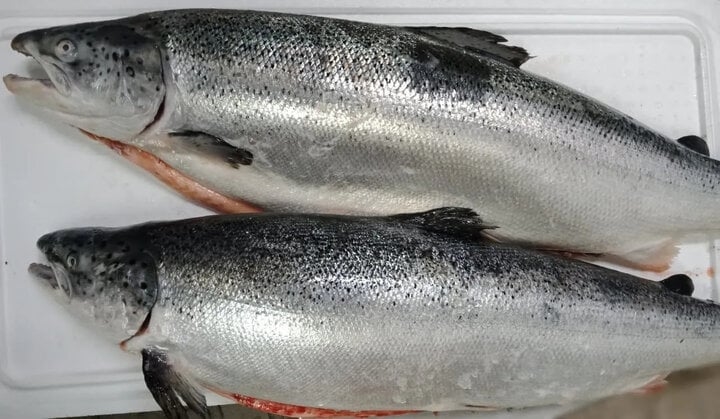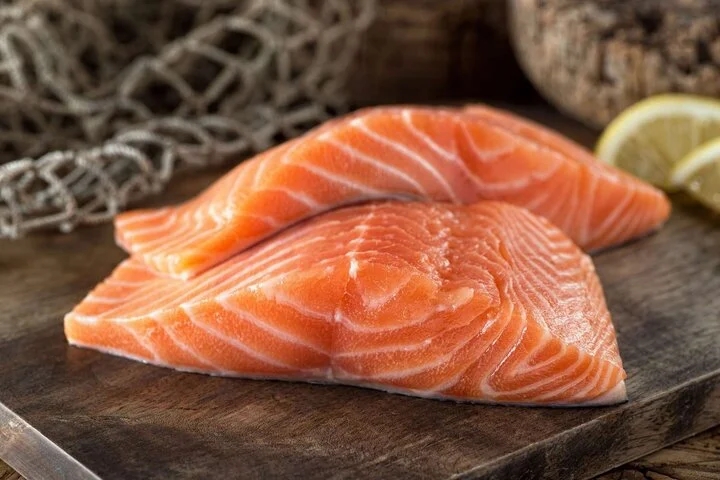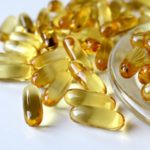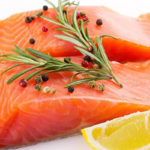Salmon is one of the most popular fish choices due to its high nutritional value and distinctive, appealing flavor. Salmon meat is an excellent source of protein, omega-3 fatty acids, and vitamins B and D, along with essential minerals.
To preserve its nutritious qualities, salmon is often prepared as sushi, fried, or cooked in a hot pot, provided the fish is fresh. Knowing how to select fresh and delicious salmon is not common knowledge.
How to Choose Fresh and Delicious Salmon

Inspecting the fish’s eyes is one way to select fresh salmon. (Photo: Qualifoods)
Inspect the eyes: Firstly, carefully observe the fish’s eyes as they are a telltale sign of its freshness. Fresh salmon will have clear, bright, and slightly bulging eyes. On the other hand, if the eyes are cloudy, sunken, or grayish, the fish is likely not fresh.
Examine the gills: Fresh gills are bright red or pink, tightly closed against the fish’s cheek, and free of slime or odor. If the gills are brown or gray and emit an unpleasant smell, the fish is not fresh and should be avoided.
Inspect the skin: Fresh salmon skin is usually shiny, bright, and firm, with intact scales that are not flaky. The skin color should be silvery or light gray with a metallic sheen. If the skin appears dull or shows signs of scale loss, the fish has likely been stored for too long.
Check the smell: Fresh salmon has a characteristic fishy smell, but it shouldn’t be overpowering. If the fish emits a strong odor, an ammonia-like smell, or any strange scent, it’s likely spoiled or no longer fresh.
Test for firmness: Gently press the fish; fresh salmon will have good resilience, and the meat will be firm. It should quickly return to its original state after pressing. If the flesh remains indented or lacks resilience, or if it feels soft and mushy, the fish is probably stale or no longer fresh.

How to choose fresh and delicious salmon? Pay attention to its texture, firmness, and color. (Photo: Allrecipes)
When buying salmon fillets, pay close attention to the texture of the meat. Fresh salmon fillets typically have a firm, cohesive texture, with seamless muscle fibers that don’t separate easily. You can also gently press the fillet with your finger to test for resilience; fresh salmon won’t retain any fingerprints. Fresh salmon fillets will also exhibit excellent resilience.
Additionally, the color of fresh salmon fillets can vary from light pink to light orange, depending on the salmon species and their origin. This color should be uniform and natural, without any dark spots or bruising.
To ensure you’re getting fresh and delicious salmon, it’s best to purchase it from reputable seafood shops or large supermarkets with proper refrigeration systems. Avoid buying salmon from unknown sources or places without adequate cold storage facilities, as this can compromise the freshness and quality of the fish.
Health Benefits of Salmon
Reduces the risk of heart disease and stroke: Salmon is rich in omega-3 fatty acids, which help improve blood cholesterol levels and regulate blood pressure. Omega-3 also reduces the risk of blood clots that can lead to blocked arteries, thus preventing heart-related issues.
Beneficial for brain health: Salmon contains unsaturated fatty acids, including DHA, which plays a crucial role in the growth and development of brain cells and the nervous system, especially in children. Therefore, pregnant women should include salmon in their diets.
Maintains eye health: Another fantastic benefit of omega-3 fatty acids is their ability to improve eye health and prevent age-related macular degeneration. The vitamin D in salmon also contributes to eye health.
Promotes muscle growth: Regular consumption of salmon helps develop lean muscle mass and boosts metabolism. Omega-3 fatty acids reduce the risk of muscle protein breakdown after exercise and aid in muscle recovery, reducing post-workout muscle soreness and fatigue.
Salmon is also rich in protein, which is essential for muscle building, as the body needs to store new protein faster than it loses old protein. People who engage in regular physical activity should include salmon in their diets to promote optimal muscle growth.
Beneficial for skin and hair: Salmon is abundant in protein, vitamin D, and omega-3 fatty acids, which improve skin texture and hair luster. Omega-3 fatty acids also protect skin cells, maintain skin hydration, and stimulate collagen production, resulting in healthy and elastic skin. Furthermore, these fatty acids nourish hair follicles, supporting healthy hair growth and acting as a natural moisturizer for the scalp and hair. As a result, salmon helps protect against sun damage and reduces the risk of skin cancer.
Aids in weight loss: Salmon is a go-to food for weight loss due to its high content of unsaturated fatty acids and protein, which induce a feeling of fullness. It’s also relatively low in calories, providing approximately 180 calories per 100-gram serving.
According to VTC News
Discover How Fish Oil Improves Skin Health and Treats Acne
“3 Simple Steps to Remove the Fishy Smell of Salmon”
Are you looking for ways to get rid of that unpleasant fishy smell associated with salmon dishes? If so, we have some useful tips that can help you make a delicious and healthy meal without the fishy odor. Keep reading to learn our easy-to-follow suggestions for removing the odorous smell from salmon dishes!
Exploring Natural Foods for Allergy Relief
Dealing with allergies can be difficult and uncomfortable, especially for young children. Allergens such as pollen, cosmetics, and insects can cause serious issues for those affected. However, knowledge of the symptoms and taking the necessary precautions can help alleviate the troublesome effects of allergies, like itching, sneezing, and irritation.





































